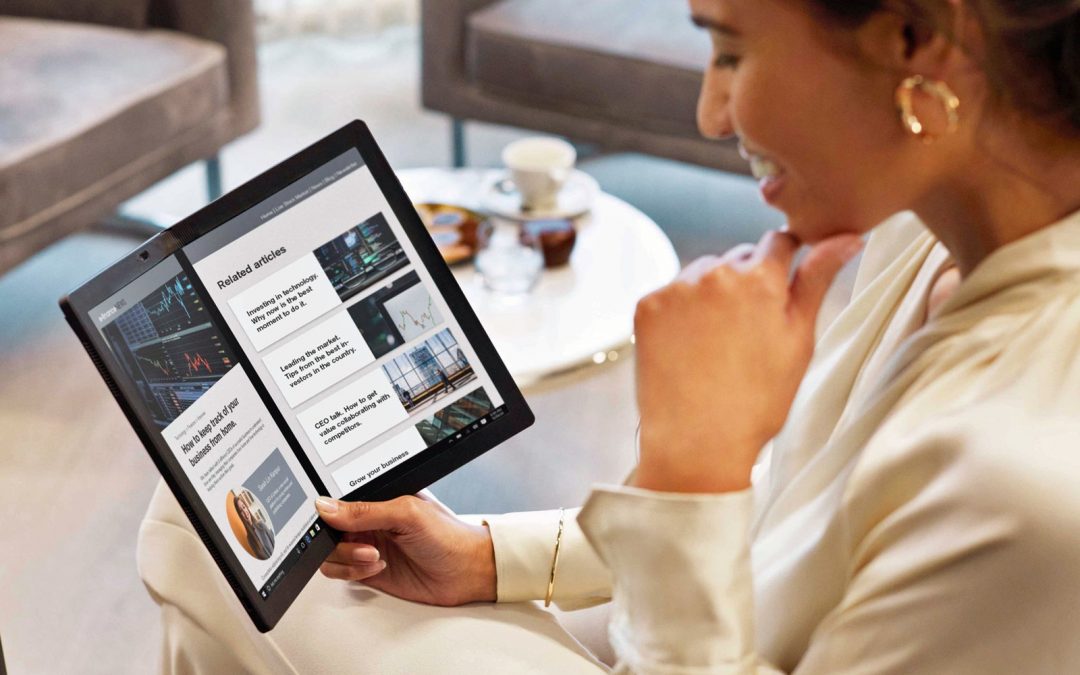In today’s always-on technological world, the roles between personal and professional devices are increasingly blurred. Users want devices that enable productivity, whether they are in the workplace, in a coffee shop or simply at home. This need for flexible and versatile technology has been the catalyst for the invention of the foldable PC category.
Creating an entirely new product category that delivers on constantly changing customer needs presents a myriad of challenges that require innovative and creative thinking, foresight, exceptional design and engineering expertise. While the process was one that took several years to perfect, solving for the complex challenges designing and engineering the world’s first foldable PC – the ThinkPad X1 Fold – into the hands of professionals was an incredible journey.
Identifying the white space for innovation
The ‘work from anywhere’ trend was on the rise years before COVID-19 impacted routines. In 2019, IWG reported that 50 percent of employees globally were working outside of their main office headquarters at least 2.5 days per week. Knowing that the trend was only going to become more prevalent, Lenovo continued thinking about what the future of portable technology would look like.
One key area of innovation was flexible and foldable OLED displays, a market that is forecasted to grow by US$ 167.7 Billion by 2024. This sparked the PC concept of “carry small, use big” that led to the creation of a whole new device category with the introduction of the world’s first foldable PC.
Designing an entirely new solution
Once the need was identified, Lenovo’s focus shifted to ideation and design. The key to a successful design was thinking of the end user experience and identifying the key components the device must have, then developing a blueprint to bring those components to life. The challenge for the X1 Fold design team became how to combine the size and portability of a smartphone, the power and functionality of a business device and the flexibility missing in the current market, to deliver on all fronts. The answer was the foldable screen.
Overcoming engineering challenges
Upon first sketches in 2016 for the world’s first foldable PC, Lenovo entered the engineering phase where the creative vision is brought to life through technical architecture. Navigating engineering challenges required a diverse team that provided a variety of perspectives in order to effectively collaborate and develop solutions to deliver a product fit for market.
In the case of the ThinkPad X1 Fold, Lenovo and Intel engineering and sub-engineering teams collaborated to engineer solutions around the device’s design, durability and usability. The main challenge was having all the system components fit within a very limited space, which was only compounded by the unique restrictions of the foldable mechanism.
The solution was identified as requiring eleven layers, inclusive of the bezel, folding OLED screen made in collaboration with LG Displays, carbon fiber shutter frame, unique cooling system and foldable graphite.
Multiple layers underneath the screen allow users to fully experience the benefits of the folding technology. What makes the ThinkPad X1 Fold truly “foldable” is the unique multi-link hinge, which was designed to protect the OLED screen when closed and provides the proper tension across the full range of motion, “pulling” the screen flat when fully opened. When combined, the layers and hinge create a positive user experience marked by durability. In addition to an unprecedented physical design, the ThinkPad X1 Fold also provides a new level of usability.
Understanding that users want an always on and always connected experience, the team designed the X1 Fold with advanced speakers and six antennas for 5G and Wi-fi connectivity. To maximize cooling, Lenovo’s team in Yokohama, Japan took inspiration from traditional Japanese mosaic woodworking, to create a revolutionary cooling system.
Tested for durability
In the last phase before the product goes to market, the end user experience needed to be refined, which requires thorough rigorous testing to ensure usability, durability, quality and functionality.
Lenovo’s devices are rigorously tested to ensure they meets or exceeds the durability legacy of the ThinkPad name. In the case of the ThinkPad X1 Fold, which pushes the boundaries of design and engineering, this was a crucial step before bringing it to market. With flexibility and foldability defining features of the product, the device was opened and closed minimum 30,000 times as part of this process to ensure the screen would maintain its integrity and functionality.
Bringing the X1 Fold to market
The South African market has a longstanding history of embracing new technologies into the African continent, and as today’s entrepreneurs tackle new challenges, the ThinkPad X1 Fold will empower users to accelerate their achievements in hyper-mobile, always on world.
The Lenovo ThinkPad X1 Fold is available for pre-order in South Africa and comes with a Bluetooth Mini Fold Keyboard and Active Pen. Pricing starts from R69,999 – price is dependent on configuration and exchange rate.
To pre-order the world’s first foldable PC, please visit: https://www.shoplenovo.co.za/lenovo-thinpad-x1-fold.
The X1 Fold will land in South African stores in early 2021.


